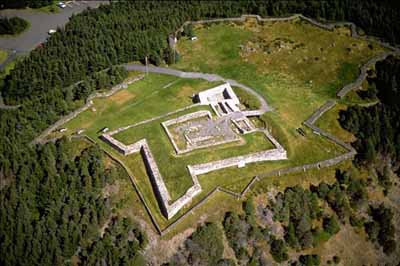Castle Hill National Historic Site of Canada
Placentia, Newfoundland and Labrador

Aerial view
© Parks Canada Agency / Agence Parcs Canada, n.d.
Address :
Route 100, Placentia, Newfoundland and Labrador
Recognition Statute:
Historic Sites and Monuments Act (R.S.C., 1985, c. H-4)
Designation Date:
1968-06-19
Dates:
-
1692 to 1762
(Construction)
-
1692 to 1811
(Significant)
-
1692 to 1713
(Significant)
-
1713 to 1811
(Significant)
Event, Person, Organization:
-
Treaty of Utrecht
(Event)
Other Name(s):
-
Castle Hill
(Designation Name)
Research Report Number:
1962-069, 2001-OB-06 Nov, 2003-SDC/CDE-056, 1962-045
DFRP Number:
00094 00
Plaque(s)
Existing plaque: in RCMP grounds Route 100, Placentia, Newfoundland and Labrador
In 1693 the French began construction of Fort Royal to guard the harbour at Placentia. When it was completed in 1703, several batteries and outworks supported the main fortifications. The defences, however, were precariously maintained throughout the French régime. Never captured, Castle Hill was ceded to Great Britain by the Treaty of Utrecht in 1713 and subsequently neglected in favour of other defences. The fort had fallen into ruins by the beginning of the 19th century.
Description of Historic Place
Castle Hill National Historic Site consists of the remains of French and British fortifications and outworks from the late 17th to the early 19th centuries that sit on the tip of a peninsula, high above Placentia Newfoundland, on the east side of Placentia Bay. It contains the remains of defensive walls, three military works, and a historic pathway.
Heritage Value
Castle Hill was designated a national historic site because: from 1692 to 1811, its defences played an important role in the defence of Placentia and the larger economic and strategic interests of France and Britain in what is now Atlantic Canada.
The heritage value of Castle Hill National Historic Site of Canada lies in its historical associations as illustrated by the remains of the 17th and 18th-century French defence works, the British blockhouse, as well as of both French (1692-1713) and British (1713-1811) occupancy. The site was stabilized and interpreted by Parks Canada as a national historic park in 1962-1968 to commemorate Placentia’s tercentenary. Archaeological investigation was conducted on the site at that time.
Source: Historic Sites and Monuments Board of Canada, Minutes, October 1971, 2001; Commemorative Integrity Statement 2002.
Character-Defining Elements
Key elements of the associative landscape include: the siting of the fortress, high up on the tip of a peninsula; remnants of the wall, Fort Royal, Gaillardin Redoubt, Detached Redoubt and the pathway in their location, extent, form, footprints, and materials; the spatial inter-relationship of these components; the craftsmanship and materials of structures remaining on the site; the archaeological resources directly linked to 17th through 19th-century military life on the site, including in situ and moveable artifacts stored by Parks Canada (pipe fragments, ceramics, glass, tools, cannon balls, gunflints, buttons, faunal remains, and assorted military equipment); the visual and physical links between these hilltop defence works and the town of Placentia such as the pathway and the viewscapes; the viewscapes from the site to in situ archaeological evidence of 18th-century military life beyond the designated place including La Fontaine Battery, former sites of Fort Louis and Fort Royal; the viewscapes from the site inland including those to Jerseyside, over Placentia Bay, and to the harbour approach from Placentia Bay; the visibility of Castle Hill from land and from the sea.